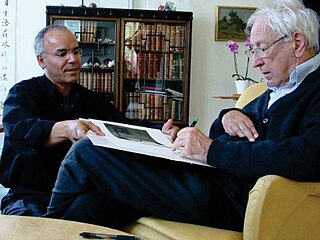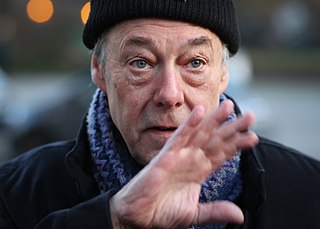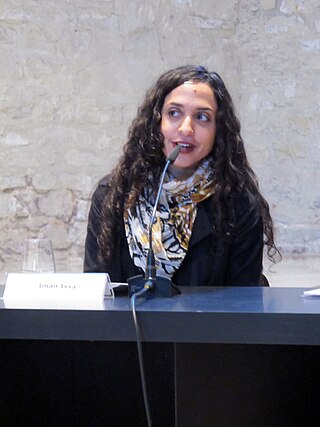Related Research Articles

Hamad bin Isa bin Salman Al Khalifa is King of Bahrain since 14 February 2002, after ruling as Emir of Bahrain from 6 March 1999. He is the son of Isa bin Salman Al Khalifa, the previous and first emir. The country has been ruled by the Al Khalifa dynasty since 1783.
Jabra Ibrahim Jabra was an Iraqi-Palestinian author, artist and intellectual born in Adana in French-occupied Cilicia to a Syriac Orthodox Christian family. His family survived the Seyfo Genocide and fled to the British Mandate of Palestine in the early 1920s. Jabra was educated at government schools under the British-mandatory educational system in Bethlehem and Jerusalem, such as the Government Arab College, and won a scholarship from the British Council to study at the University of Cambridge. Following the events of 1948, Jabra fled Jerusalem and settled in Baghdad, where he found work teaching at the University of Baghdad. In 1952 he was awarded a Rockefeller Foundation Humanities fellowship to study English literature at Harvard University. Over the course of his literary career, Jabra wrote novels, short stories, poetry, criticism, and a screenplay. He was a prolific translator of modern English and French literature into Arabic. Jabra was also an enthusiastic painter, and he pioneered the Hurufiyya movement, which sought to integrate traditional Islamic art within contemporary art through the decorative use of Arabic script.
Osman Waqialla, was a 20th century Sudanese painter and calligrapher, noted for his creative use of Arabic letter forms in his artworks, thereby integrating African and Islamic cultural traditions into the contemporary art of Sudan. This use of Arabic calligraphy as a modern, non-religious graphic form places Waquialla within the Arabic art movement that became known as the Hurufiyya movement.
Salah Taher (1911–2007) was an Egyptian painter.
Nedim Kufi, born 1962 in Baghdad), is an Iraqi-Dutch multi disciplinary visual artist. He is primarily known for conceptual art that explores themes such as war, political conflict, exile, loss, and historical memory. Much of his work contains autobiographical elements. He is also a graphic designer and print maker.

Modhir Ahmed is an Iraqi-Swedish artist.

Shaikh Rashid bin Khalifa Al Khalifa is a member of the Bahraini royal family, an artist and the chairman of Bahrain's National Council for Arts. He is the first president and the current honorary president of the Bahrain Arts Society. He has painted over a period of 50 years, beginning with landscape painting in the late 1960s. His recent work continues to explore his immediate landscape and the traditional architecture of his homeland, through wall based, structural installations created with aluminium. He is widely considered one of the Kingdom's most renowned artists.
Firyal Al Adhamy Al-Adhamy is a Bahrain-based British Iraqi artist.

Gerald David "Gerry" Badger is an English writer and curator of photography, and a photographer.

Mourad Salem is a Tunisian artist based in Paris, France. His works question historical leaders, often depicting them as immature power-hungry figures. In 2013, Salem's exhibition "Sultans Are No Sultans" debuted at the Nour Festival of Arts from the Middle East and North Africa at the Leighton House Museum in London. Salem is of Turkish origin.

Hassan Hajjaj, is a Moroccan contemporary artist and photographer who lives and works between London, United Kingdom, and Marrakech, Morocco. He is known for his portrait photographs.

Iman Issa is an Egyptian multi-disciplinary artist whose work looks at the power of display in relation to academic and cultural institutions at large.

Dia Al-Azzawi is an Iraqi painter and sculptor, who lives and works in London. He is one of the pioneers of modern Arab art and is noted for incorporating Arabic script into his paintings. Active in the arts community, he founded the Iraqi art group known as New Vision and has been an inspiration to a generation of young, calligraffiti artists.
The Hurufiyya movement (Arabic: حروفية ḥurūfiyyah adjectival form ḥurūfī, 'of letters' is an aesthetic movement that emerged in the second half of the twentieth century amongst artists from Muslim countries, who used their understanding of traditional Islamic calligraphy within the precepts of modern art. By combining tradition and modernity, these artists worked towards developing a culture-specific visual language, which instilled a sense of national identity in their respective nation-states when many of these states were shaking off colonial rule and asserting their independence. They adopted the same name as the Hurufi, an approach of Persian Sufism which emerged in the late 14th–early 15th century. Art historian Sandra Dagher has described Hurufiyya as the most important movement to emerge in Arabic art in the 20th century.
Rafa al-Nasiri was an Iraqi painter, draughtsman, print-maker, educator and author whose works with a social and political message resonated with the Iraqi public in the mid-20th century. He was also very influential in encouraging young artists to take up print-making.

Barjeel Art Foundation is a non-profit arts organisation based in Sharjah, United Arab Emirates. The foundation was established in 2010 by Emirati commentator Sultan Sooud Al Qassemi to manage and exhibit his personal art collection. There are over 1,000 pieces of modern and contemporary art in the foundation's art collection. The organisation primarily focuses on artwork produced by Arab artists worldwide and includes paintings, sculptures and installations.
Sayyid Ali Muhammad-Ali Al Tajer is an Iraqi painter and art historian. He studied drawing at the University of Baghdad's College of Fine Arts. He currently stands as a member of the Association of Iraqi Artists, as well as the Organization of Iraqi Fine Artists.
Noor Al Suwaidi is an artist and curator from the United Arab Emirates.
Ahmed Shibrain, also known as Ahmad Mohammad Shibrain was a Sudanese Modernist painter and Dean of the College of Fine and Applied Art in Khartoum.
References
- 1 2 3 "Collections Online | British Museum". www.britishmuseum.org. Retrieved 2020-12-06.
- 1 2 3 4 5 6 Marray, Deniz (2014-11-11). "Kurdish-Iraqi artist Walid Siti on conflict and loss". Arab News . Retrieved 2021-08-30.
- ↑ "Walid Siti: My work navigates a complex terrain of memory and loss". Culture Project for Art, Feminism and Gender. Retrieved 2023-01-02.
- 1 2 3 "Walid Siti - New Babylon". universes.art. Retrieved 2020-12-06.
- ↑ "Walid Siti". Framer Framed. Retrieved 2020-12-06.
- ↑ "Alienation". Barjeel Art Foundation. 2012-03-24. Retrieved 2020-12-06.
- ↑ "Bahrain Authority for Culture and Antiquities - Kingdom of Bahrain | Past Events". culture.gov.bh. Retrieved 2020-12-06.
- ↑ "Photos of the exhibition. Walid Siti: The Black Tower". universes.art. Retrieved 2020-12-06.
- ↑ Siti, Walid; Sahakian, Rijin; Muller, Nat; Bahraini, Zainab; Porter, Venetia; Sahakian, Rijin; Johnson, Sarah (2020-09-27). Walid Siti. Kehrer Verlag Heidelberg, Klaus Kehrer. ISBN 978-3-86828-927-5.